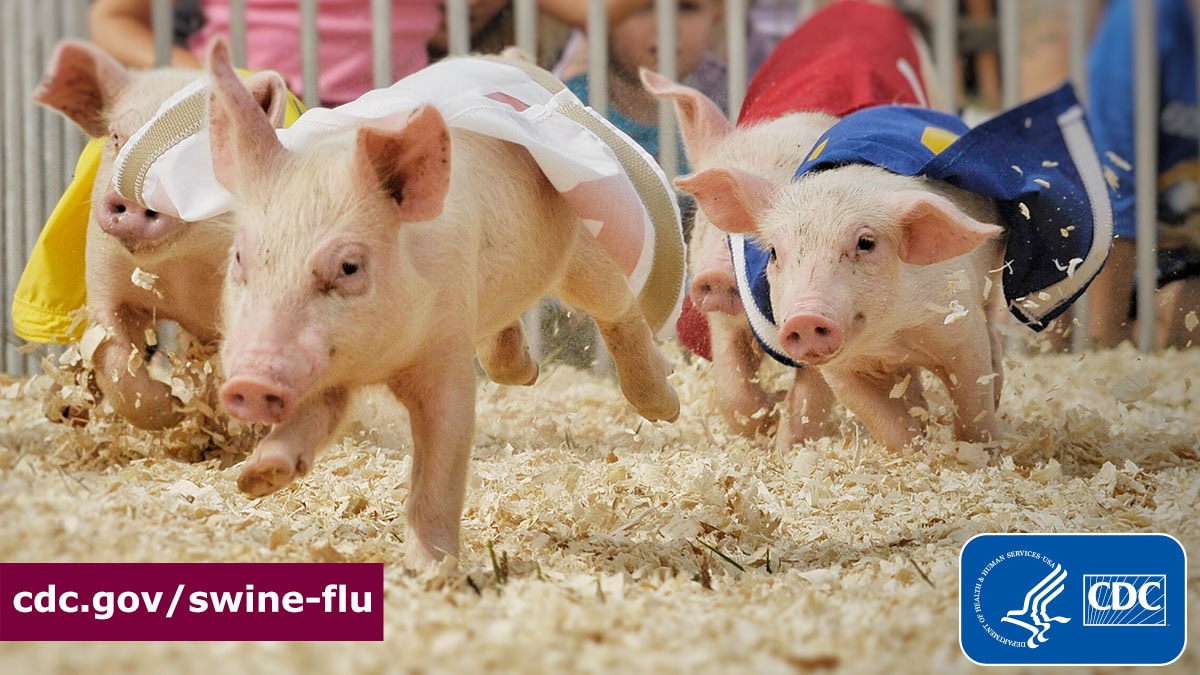What to know
On November 13, 2023, the Swine Exhibitions Zoonotic Influenza Working Group met to update the "Measures to Minimize Influenza Transmission at Swine Exhibitions" document. The suggested prevention measures include activities before, during, and after swine exhibitions to help prevent the spread of influenza A viruses from people to pigs and from pigs to people.

CDC Update
November 13, 2023 – Last week the Swine Exhibitions Zoonotic Influenza Working GroupA met to update the "Measures to Minimize Influenza Transmission at Swine Exhibitions" document. The suggested prevention measures include activities before, during, and after swine exhibitions to help prevent the spread of influenza A viruses from people to pigs and from pigs to people. The update will be available for reference upon completion in 2024 on several partner web pages and conference presentations, and it will also be submitted to a scientific journal for publication for the first time.
More than 150 million people visit agricultural fairs each year in North America. Every year, there are rare sporadic human infections with influenza viruses that are usually found in pigs. These infections, which are called "variant influenza" virus infections in people, have most commonly been reported after exposure to infected pigs, such as in pig barns and livestock exhibits housing pigs at fairs. While variant influenza virus infections usually cause mild illness in people, they are concerning because they can cause severe illness, especially in people at higher risk of serious flu complications, and because of their pandemic potential.
The Swine Exhibitions Zoonotic Influenza Working Group is comprised of CDC staff, state, federal, and national partners and other leaders and academics in the agricultural industry. The measures for prevention are written collaboratively with input from these multiple perspectives.
Updating the Measures to Minimize Influenza Transmission at Swine Exhibitions
The Swine Exhibitions Zoonotic Influenza Working Group first gathered in December 2012 to develop a set of measures to minimize the spread of influenza viruses at swine exhibitions. The group reviewed the document again in 2014 and 2015 and made minor updates. In 2016, because of important new data regarding the spread of influenza viruses between pigs at exhibitions, the measures for prevention were expanded and strengthened. In 2018, a checklist for exhibition organizers and youth organization leaders was added to accompany the suggested measures. This routine update will incorporate new data that have been published in peer-reviewed literature to further strengthen and inform the existing measures. The updated version will also be reorganized to be more user-friendly and will offer more tools to assist with implementing the prevention strategies.
The measures to minimize influenza virus transmission document has sections specific to fair exhibition organizers, youth organization leaders, fair exhibitors, and state animal and public health officials. In addition to suggested precautions to take before, during, and after swine exhibitions, the document also includes measures to consider if during an agricultural exhibition there are variant influenza virus infections in people, or an unexpected amount of swine influenza in pigs.
Background on Human Infections with Variant Influenza Viruses
Influenza viruses can spread from pigs to people and from people to pigs. Infected pigs can cough or sneeze, and droplets with virus in them can spread through the air. If these droplets land in a person's nose or mouth, or are inhaled, they can lead to infection. When swine influenza viruses are found in people, they are called "variant influenza virus" infections and designated with the letter "v" after the influenza subtype.
In 2005, human infection with a novel influenza A virus became nationally notifiable in the United States. Novel influenza A viruses are different from currently spreading human influenza H1 and H3 viruses and include variant influenza viruses and avian (bird) influenza viruses. Since that time, a total of 513 variant influenza virus infections (of different influenza A virus subtypes) have been identified in the United States and reported to CDC. The number of variant influenza virus infections identified each year range from a high of 321 variant influenza virus infections during the 2011-2012 flu season to a low of one infection each during the 2018-2019 and 2019-2020 seasons. More than 90 percent of the infections reported during the 2011-2012 flu season were associated with pig exposure and/or attendance at an agricultural fair.
Each variant influenza virus infection should be fully investigated to determine if the viruses are spreading in an efficient and ongoing way in people and to limit further exposure of people to infected animals if infected animals are identified.
CDC recommends people take precautions to prevent the spread of influenza viruses between pigs and people and has guidance for people exhibiting pigs at fairs, people attending fairs, and fair organizers.
- Partners include the National Assembly of State Animal Health Officials (representing Boards of Animal Health and Agriculture for multiple states), National Association of State Public Health Veterinarians, American Association of Swine Veterinarians, National Pork Board, National Swine Registry, the International Association of Fairs and Expositions, 4-H, National FFA Organization, Iowa State Center for Food Security and Public Health, Ohio State Swientist Program, United States Department of Agriculture, Centers for Disease Control and Prevention, and academic colleagues.
